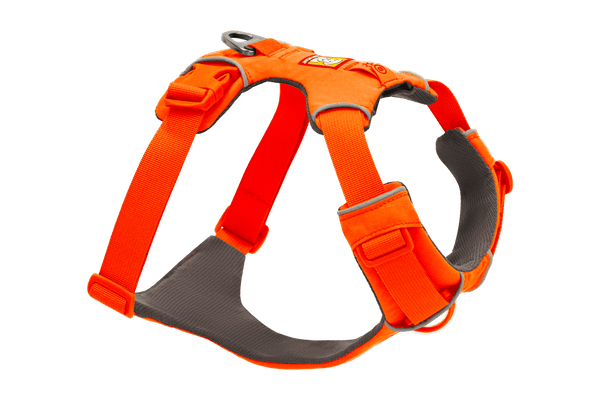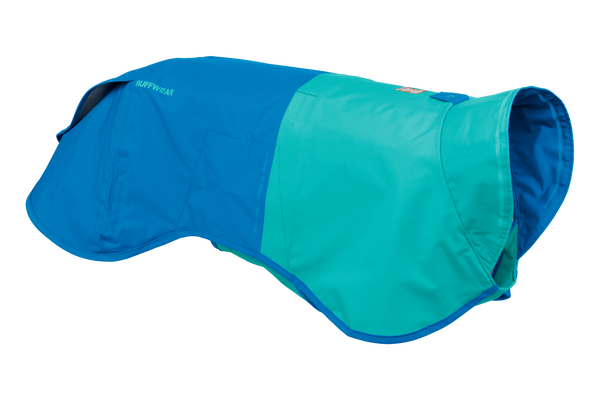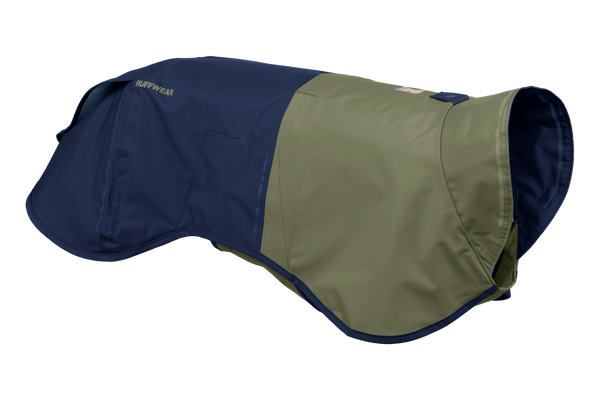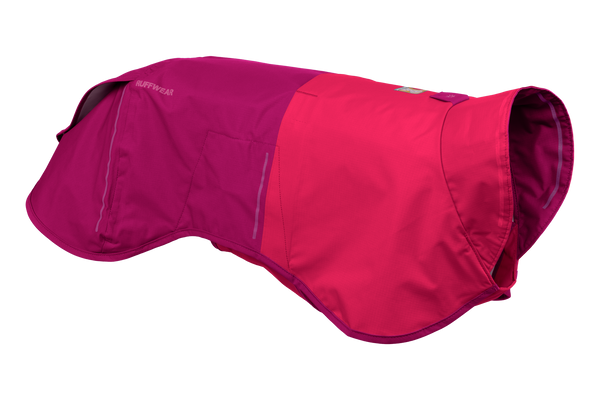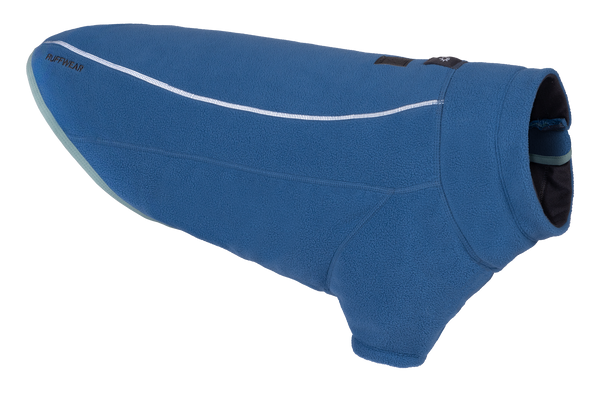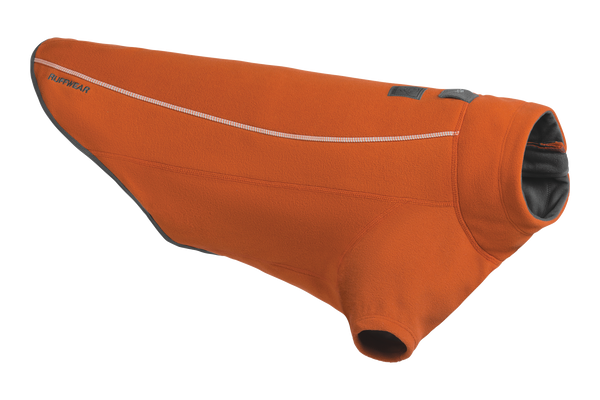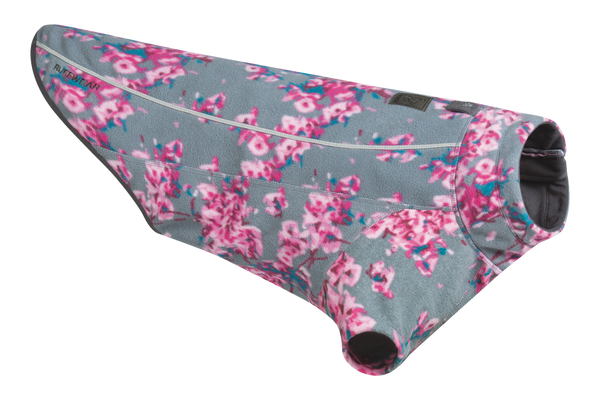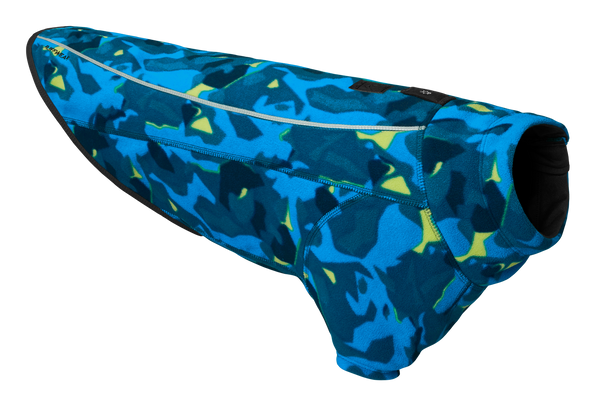Mit unserem neuen Nachhaltigkeitsmanager über Kohlenstoff und Haie sprechen
Ruffwear hat kürzlich David Bennett (und seinen Hund Ginger) als Senior Sustainability Manager im Team willkommen geheißen. Wir haben uns vor Kurzem getroffen, um mehr über ihn und die Arbeit des Teams zur Unterstützung des Nachhaltigkeitsprojekts von Ruffwear zu erfahren.
Zunächst einmal wollen wir einige wichtige Informationen besprechen. Was ist:
Dein liebster Snack für unterwegs? Bananen. Und Ingwer bekommt die obersten und untersten Teile – ich mochte diese harten kleinen Teile der Banane noch nie.
Gingers derzeit liebste RW-Ausrüstung? Die Bivy™-Schüssel
Ihr Lieblingswanderweg, auf dem Sie je waren? Wolf Ridge (George Washington National Forest)
Gingers besondere Marotte oder geheimes Talent? Meine Lieblingsmarotte bei Gingers ist, dass sie übermäßig und unnötig wählerisch ist, von wem sie sich streicheln lässt.
Dein geheimes Talent? Ich kann Kinderlieder auf Abruf/in Echtzeit schreiben.

Okay, jetzt zum Üblichen – können Sie sich, Ihren Hund und Ihre Rolle hier bei Ruffwear vorstellen?
Ich bin David, und meine 10-jährige Hündin Ginger ist bei meiner Frau und mir, seit wir sie im Alter von acht Wochen vom SPCA adoptiert haben. Ginger hat viel Zeit auf Trailruns und Skilanglauf verbracht, aber heutzutage geht es eher ums Campen mit dem Auto, Spaziergänge auf unseren örtlichen Wanderwegen und darum, ihre Füße in einen nahegelegenen Fluss oder See zu stecken.
Bei Ruffwear bin ich Mitglied des Supply Chain-Teams, wo ich mich auf die Unterstützung von Nachhaltigkeitsinitiativen in all unseren Betriebsabläufen und Produkten konzentriere. Das umfasst also alles, von der Auswahl der Materialien bis hin zur Art und Weise, wie unsere Endprodukte in die Hände unserer Kunden gelangen.

An welcher Sache arbeiten Sie gerade, die Sie besonders begeistert?
Ein Projekt, das mich wirklich begeistert, ist die Arbeit, die wir derzeit an der Entwicklung des ersten Klimaaktionsplans von Ruffwear leisten. Ich bin wirklich begeistert davon, wie der Plan Gestalt annimmt – er enthält eine detaillierte Einschätzung unseres aktuellen Stands in Bezug auf unsere jährlichen Treibhausgasemissionen sowie ein Ziel für die prozentuale Reduzierung dieser Emissionen, die wir anstreben.
Das Tolle an unserem Reduktionsziel ist, dass wir uns auf großartige wissenschaftliche Erkenntnisse stützen, die uns sagen, wie viel wir bis wann (unser Zieldatum) reduzieren sollten. Ein wissenschaftlich fundiertes Ziel verleiht der Arbeit viel Integrität und ich denke, das ist jedem im Ruffwear-Team wichtig.
Daher bin ich auf jeden Fall begeistert von der Arbeit, die wir zur Entwicklung dieses Plans leisten, und ich bin auch sehr gespannt auf die Arbeit, die wir in den kommenden Jahren leisten werden, um unsere Klimaziele zu erreichen.

„Nachhaltigkeit“ kann so vieles bedeuten. Was bedeutet es bei Ruffwear?
Nachhaltigkeit ist Teil der Ruffwear-Geschichte, seit unser Gründer Patrick Anfang der 1990er Jahre mit der Entwicklung von Produkten begann. Was es damals bedeutete, sieht anders aus als heute. Und wir sind dabei, (intern) zu klären, was wir meinen, wenn wir „Nachhaltigkeit“ sagen.
Wenn wir bei Ruffwear derzeit über Nachhaltigkeit nachdenken, fallen uns sechs wichtige Einflussbereiche ein:
- Kohlenstoff und Energie
- Chemie
- Erhaltung
- Abfall
- Wasser
- Soziale Verantwortung der Lieferanten
Ein Beispiel dafür, wie wir mehr Gutes tun wollen, ist unser Ziel, bis 2030 klimapositiv zu sein. Das bedeutet, dass wir in den nächsten Jahren unsere Treibhausgasemissionen im Einklang mit einem wissenschaftlich fundierten Ziel reduzieren werden. Außerdem wollen wir mehr Treibhausgase aus der Atmosphäre entfernen, als wir ausstoßen, und uns gleichzeitig für einen umfassenderen systemischen Wandel in Bezug auf die Klimapolitik und den Schutz natürlicher Ressourcen einsetzen.
Dies ist eine wirklich ehrgeizige Aufgabe, und wir versuchen keineswegs, sie allein zu bewältigen – wir sind Teil des Climate Action Corps der Outdoor Industry Association, einer Gruppe vergleichbarer Unternehmen der Outdoor-Branche, die ähnliche Ziele haben und wirklich hart daran arbeiten, etwas zu bewirken.

Welche Verbesserungsmöglichkeiten gibt es für Ruffwear und wie möchte Ruffwear in diesen Bereichen Fortschritte erzielen?
Ein Bereich, in dem wir uns verbessern möchten, ist eine detailliertere Karte, die genau zeigt, wo und wie die Materialien, aus denen unsere Produkte bestehen, durch unser Lieferantennetzwerk fließen.
Lieferantennetzwerke sind oft tiefer und komplizierter, als die meisten Menschen glauben, und es ist wirklich schwierig, diese Netzwerke zu verstehen. Aber es ist ziemlich wichtig, eine klare und genaue Karte dieses Netzwerks zu erstellen, damit wir unsere ökologischen und sozialen Auswirkungen messen und optimieren können.
Sie haben Kohlenstoff und Kohlendioxid mehrmals erwähnt. Warum hat die Konzentration auf Kohlenstoff eine so hohe Priorität?
Kohlendioxid ist ein Treibhausgas und steht daher in direktem Zusammenhang mit dem Klimawandel. Der Klimawandel ist ein dringendes Problem mit weitreichenden Auswirkungen – einige dieser Folgen spüren wir bereits jetzt.
In der traditionellen Naturschutzarbeit (wo ich meine Karriere begann) liegt der Schwerpunkt oft auf dem Schutz und der Wiederherstellung von Populationen von Arten, die sich weit oben in der Nahrungskette befinden. Wenn Sie Ihre Bemühungen auf dieser höheren Ebene konzentrieren, gehen Sie letztendlich viele der zugrunde liegenden Probleme an, die das Netz von Arten und Lebensräumen beeinflussen, auf das die Spitzenprädatoren angewiesen sind.
Das heißt: Wenn Sie sich für den Schutz der Haie einsetzen, schützen Sie letztendlich auch den Thunfisch, den diese Haie fressen, und die anderen Fische und Wirbellosen, die diese Thunfische fressen. Und was wichtig ist: Sie schützen letztendlich auch die Wasserlebensräume, die den Arten auf allen Ebenen der Nahrungskette als Nahrung und Schutz dienen.
Je weiter Sie stromaufwärts zielen, desto mehr Vorteile können Sie stromabwärts erzielen.
Dem Klimawandel Priorität einzuräumen ist ein bisschen so, als würde man sich beim Artenschutz auf Haie konzentrieren, denn der Klimawandel bringt eine Reihe von Problemen mit sich, die sich aus den Veränderungen unseres Klimas ergeben - von der Qualität unserer Luft und unseres Wassers bis hin zu unseren Wettermustern.
Für Ruffwear kann sich unser Fokus auf den Klimawandel auf verschiedene Weise zeigen. Wir haben beispielsweise Maßnahmen ergriffen, wie die Installation von Solarmodulen auf dem Dach unseres Firmensitzes.
Die Frage, wie wir unsere Kohlendioxidemissionen im großen Maßstab reduzieren können, hängt im Wesentlichen von unseren Produkten ab – von den Materialien, die wir zur Herstellung unserer Produkte auswählen, vom Energiemix, der in den Anlagen zur Herstellung dieser Produkte eingesetzt wird, und auch von der Energie, die erforderlich ist, um diese Produkte zu unseren Kunden zu bringen.
Ich habe dies bereits kurz erwähnt, aber es ist eine weitere Erwähnung wert: Ruffwear kann eine Dekarbonisierung in diesem Ausmaß nicht allein bewältigen. Um die Einführung von Energieeffizienz und erneuerbarer Energie in unserem Versorgungsnetz zu beschleunigen, müssen wir unbedingt mit Kollegen aus unserer Branche zusammenarbeiten, die Kunden derselben Lieferanten sind, mit denen wir zusammenarbeiten.
Das klingt nach der Arbeit des Climate Action Corps, an dem Ruffwear beteiligt ist. Können Sie kurz erklären, was das Climate Action Corps ist und wie Ruffwear daran beteiligt ist?
Beim Climate Action Corps (dem Corps) geht es um die Teilnahme an einer branchenweiten Initiative zur gemeinsamen Bekämpfung unserer Umweltauswirkungen. Wir sind dem Corps als Gründungsmitglied beigetreten und werden im Rahmen unserer Verpflichtung gegenüber dem Corps Folgendes tun:
- Messen Sie unseren aktuellen CO2-Fußabdruck
- Setzen Sie sich ehrgeizige Ziele zur Reduzierung der Treibhausgasemissionen
- Erstellen Sie spezielle Pläne für Ruffwear und verfolgen Sie die Reduzierungen im Laufe der Zeit
- Unsere Fortschritte jedes Jahr öffentlich bekannt geben
Wir werden mit anderen Mitgliedern des Corps bei der Reduzierung der CO2-Emissionen zusammenarbeiten und sicherstellen, dass wir gemeinsam eine Kraft für den Klimaschutz sind. Weitere Informationen dazu, wie das alles aussehen kann, finden Sie hier .

Großartig. Danke, David. Das Thema Nachhaltigkeit ist tiefgründig und komplex, aber dennoch von zentraler Bedeutung für die Arbeit von Ruffwear. Wie können Leute, die unsere Reise verfolgen und über unsere Fortschritte auf dem Laufenden bleiben möchten, mehr erfahren?
Teil von Ruffwears Nachhaltigkeitsstrategie ist es nicht nur, die Arbeit zu erledigen, sondern auch , transparent damit umzugehen . Wir veröffentlichen Updates auf dem Ruffwear-Blog und in unseren E-Mails. Informationen zur Materialauswahl finden Sie auf den Produktseiten. Erst kürzlich hat das Climate Action Corps seinen Fortschrittsbericht für das erste Jahr veröffentlicht, in dem wir vorgestellt wurden – Sie können ihn hier nachlesen .
